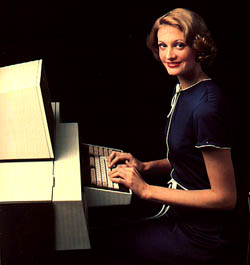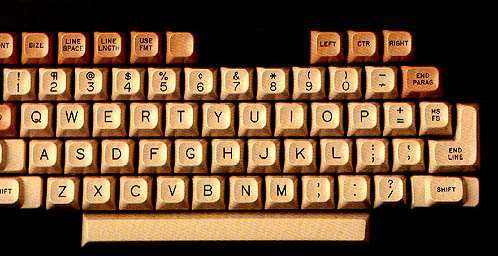|
The Quadritek photo typesetting system was an early solution to "affordable" typesetting. Built by the Itek Corporation (which no longer exists), the machine was marketed to small businesses, educational institutions and other organizations who needed to do in-house publishing. The Quadritek was the first of several machines built by Itek that was supposed to make typesetting affordable. Starting at $17,000 the 1200 found its niche in markets where the cost of an even more expensive machine like the Compugraphic could not be justified. The Quadritek was the ideal step up from setting type on archaic machines like the IBM Composer, which was similar to the IBM selectric typewriter. The Quadritek 1200 was the first in a series to come to market. From 1977 to the mid 1980s, Itek built and sold several models of these machines, each with upgraded operating systems, font and memory storage systems to a point where the last model, called the "Digitek" featured a what you see is what you get graphical interface.
If you were setting type by hand or on an IBM composer, the benefits of having a Quadritek were immense. The IBM composer could only set type up to 12 or 14 points. Anything else larger required you to use press on lettering or a headlining machine. The Quadritek allowed users to have 4 fonts online at the same time. Compared to having only one font online with the old IBM composer, this was a huge step forward. Type sizes ranged from 5 1/2 points to 36 points. Later models offered point sizes of up to 72 and later 128. Unlike today's digital fonts, Quadritek fonts came on a glass wafer for each weight which contained the entire alphabet, numbers and special symbols and punctuation. Digital bar codes on each wafer was read on the fly into the typesetters microprocessor, which in turn lined up the imaging mechanism to set the type at the selected size and style onto a photo sensitive paper. The output was run through a chemical process, dried and later pasted up to a layout board. Whatever was typed into the Quadritek could be saved to a cassette data tape. Later Quadritek models saved files to 8 and 5.25 inch floppy discs. Files could be saved, edited and played back later without having to be rekeyed from scratch. This was cutting edge technology in 1977 and saved users a lot of keyboarding time. Drawbacks of the Quadritek 1200 The biggest drawback in using the Quadritek or any other computerized phototypesetting unit of the time was mastering the complex, command line interface. This was not a "What You See Is What You Get (WYSIWYG)" system common to today's computers. Setting type on the Quadritek required users to memorize common mnemonic code and key combinations in order to get the type set at the right size, style, length, width, etc. Every action along the way had to be coded using commands to tell the machine to turn type attributes such as bold, regular or italic on or off. Needless to say, beginning users made many mistakes by not entering the end codes to each transaction. This usually resulted in an entire paragraph or possibly job could being set in all bold. To make matters worse, most users never knew it until after the job was printed! Users had to review the job to see where the mistake first occurred, and fix it. With the tape system, this meant playing back the cassette one line at the time to find where the mistake was made and then key in the correct command sequence. Users had to also transfer the tape from the playback drive to the record drive. Very tedious stuff. The display on the quadritek consisted of a 13 inch amber or green on black text monitor. The 1200 displayed 4 lines of type on the input field and 4 lines of type on the output field which occupie the screen at the same time. Later models offered a "what you see is what you get" second monitor option. As mentioned earlier, type was set to photosensitive paper which had to be processed chemically and then be set to dry before being pasted up. Text output to photopaper was around 900 to 1200 dpi. This set the Quadritek apart from early laser printers which managed only a 300 dpi image. Technology for computers (Macs and PC) eventaully passed that of the dedicated typesetting machines and hastened the path to obsolescence. The Macintosh killed the Quadritek In 1984 Apple introduced the Macintosh computer and revolutionized the entire publishing industry. The Macintosh offered a very easy to use interface, which eventually made the art of typesetting and computer graphic design available to the masses. Coupled with the highly successful laser printer, the Macintosh brought publishing within the realm of the everyday user. Hard core typesetters who cut their chops on machines like the Quadritek and the more popular Compugraphic systems, along with their pen and ink graphic artist counterparts, quickly adopted the Macintosh as a tool to learn and master. In time Apple noticed that the publishing industry flocked to Macs like bees to a hive. They and several other companies pushed Macintosh (and later PC) technology to the point that rendered all of the stand-alone photo typesetting systems obsolete. There probably isn't a soul on Earth who uses a Quadritek or similar typesetting equipment today. All of those machines have probably gone the way of hot metal type and inking machines of days gone by. The digital revolution is here to stay. OCTOBER 10, 2003 UPDATE: I was going through some of my old Macintosh floppy discs when I found an instruction sheet that I wrote on how to use the Quadritek 2100. This sheet was written as a quick and dirty basic guide to help people at my workplace on how to use the machine in the event that I was gone or something. The actual documentation that came with these machines were in many booklets that were several pages long.
 June 29, 2003
June 29, 2003Hey Mel, Stumbled across your Quadritek page tonight. What a blast from the past! Mahalo nui. I had fun reading about the old Itek.
Aloha, --
Blaine Fergerstrom | ZZ-Type | http://www.zztype.com | http://alohatown.com Blaine used to work for the company that sold and serviced these machines in the Hawaii market. He also owned one when he ran his old graphics business in the 1980s.
Copyright 2002 - 2010 Melvin Ah Ching Productions. Last update to this page: January 21, 2013. |

